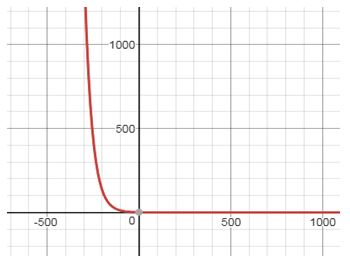
Concept explainers
Radioactive Decay Strontium-90 is a radioactive material that decays according to the function , where is the initial amount present and is the amount present at time (in years). Assume that a scientist has a sample of 500 grams of strontium-90.
(a) What is the decay rate of strontium-90?
(b) Graph the function using a graphing utility.
(c) How much strontium-90 is left after 10 years?
(d) When will 400 grams of strontium-90 be left?
(e) What is the half-life of strontium-90?
To find:
a. What is the decay rate of strontium-90?
Answer to Problem 3AYU
Solution:
a.
Explanation of Solution
Given:
Calculation:
a. Compare where is a negative number that represents the rate of decay. We will get the values of as .
On converting the percentage,
Notation .
Therefore the decay rate of strontium-90 is .
To find:
b. Graph the function using a graphing utility.
Answer to Problem 3AYU
Solution:
b.

Explanation of Solution
Given:
Calculation:
b. Graph:

To find:
c. How much strontium-90 is left after 10 years?
Answer to Problem 3AYU
Solution:
c.
Explanation of Solution
Given:
Calculation:
c. Substitute 10 for and 500 for in the given function.
Therefore the amount of strontium 90 left after 10 years is about grams.
To find:
d. When will 400 grams of strontium-90 be left?
Answer to Problem 3AYU
Solution:
d.
Explanation of Solution
Given:
Calculation:
d. Substitute 400 for in the given function.
Taking log on both sides we get,
Therefore, 400 grams of strontium 90 will be left after about years.
To find:
e. What is the half-life of strontium-90?
Answer to Problem 3AYU
Solution:
e.
Explanation of Solution
Given:
Calculation:
e. Half life is the time required for half of the radioactive substance to decay. Since is the initial amount of strontium 90.
Replace in the given function.
Taking log on both sides we get,
Therefore, the half life of strontium 90 is years.
Chapter 5 Solutions
Precalculus
Additional Math Textbook Solutions
University Calculus: Early Transcendentals (4th Edition)
Elementary Statistics: Picturing the World (7th Edition)
Elementary Statistics (13th Edition)
College Algebra (7th Edition)
Algebra and Trigonometry (6th Edition)
Calculus for Business, Economics, Life Sciences, and Social Sciences (14th Edition)
- Consider the function f(x) = x²-1. (a) Find the instantaneous rate of change of f(x) at x=1 using the definition of the derivative. Show all your steps clearly. (b) Sketch the graph of f(x) around x = 1. Draw the secant line passing through the points on the graph where x 1 and x-> 1+h (for a small positive value of h, illustrate conceptually). Then, draw the tangent line to the graph at x=1. Explain how the slope of the tangent line relates to the value you found in part (a). (c) In a few sentences, explain what the instantaneous rate of change of f(x) at x = 1 represents in the context of the graph of f(x). How does the rate of change of this function vary at different points?arrow_forward1. The graph of ƒ is given. Use the graph to evaluate each of the following values. If a value does not exist, state that fact. и (a) f'(-5) (b) f'(-3) (c) f'(0) (d) f'(5) 2. Find an equation of the tangent line to the graph of y = g(x) at x = 5 if g(5) = −3 and g'(5) = 4. - 3. If an equation of the tangent line to the graph of y = f(x) at the point where x 2 is y = 4x — 5, find ƒ(2) and f'(2).arrow_forwardDoes the series converge or divergearrow_forward
- Suppose that a particle moves along a straight line with velocity v (t) = 62t, where 0 < t <3 (v(t) in meters per second, t in seconds). Find the displacement d (t) at time t and the displacement up to t = 3. d(t) ds = ["v (s) da = { The displacement up to t = 3 is d(3)- meters.arrow_forwardLet f (x) = x², a 3, and b = = 4. Answer exactly. a. Find the average value fave of f between a and b. fave b. Find a point c where f (c) = fave. Enter only one of the possible values for c. c=arrow_forwardplease do Q3arrow_forward
- Use the properties of logarithms, given that In(2) = 0.6931 and In(3) = 1.0986, to approximate the logarithm. Use a calculator to confirm your approximations. (Round your answers to four decimal places.) (a) In(0.75) (b) In(24) (c) In(18) 1 (d) In ≈ 2 72arrow_forwardFind the indefinite integral. (Remember the constant of integration.) √tan(8x) tan(8x) sec²(8x) dxarrow_forwardFind the indefinite integral by making a change of variables. (Remember the constant of integration.) √(x+4) 4)√6-x dxarrow_forward
 Calculus: Early TranscendentalsCalculusISBN:9781285741550Author:James StewartPublisher:Cengage Learning
Calculus: Early TranscendentalsCalculusISBN:9781285741550Author:James StewartPublisher:Cengage Learning Thomas' Calculus (14th Edition)CalculusISBN:9780134438986Author:Joel R. Hass, Christopher E. Heil, Maurice D. WeirPublisher:PEARSON
Thomas' Calculus (14th Edition)CalculusISBN:9780134438986Author:Joel R. Hass, Christopher E. Heil, Maurice D. WeirPublisher:PEARSON Calculus: Early Transcendentals (3rd Edition)CalculusISBN:9780134763644Author:William L. Briggs, Lyle Cochran, Bernard Gillett, Eric SchulzPublisher:PEARSON
Calculus: Early Transcendentals (3rd Edition)CalculusISBN:9780134763644Author:William L. Briggs, Lyle Cochran, Bernard Gillett, Eric SchulzPublisher:PEARSON Calculus: Early TranscendentalsCalculusISBN:9781319050740Author:Jon Rogawski, Colin Adams, Robert FranzosaPublisher:W. H. Freeman
Calculus: Early TranscendentalsCalculusISBN:9781319050740Author:Jon Rogawski, Colin Adams, Robert FranzosaPublisher:W. H. Freeman
 Calculus: Early Transcendental FunctionsCalculusISBN:9781337552516Author:Ron Larson, Bruce H. EdwardsPublisher:Cengage Learning
Calculus: Early Transcendental FunctionsCalculusISBN:9781337552516Author:Ron Larson, Bruce H. EdwardsPublisher:Cengage Learning





